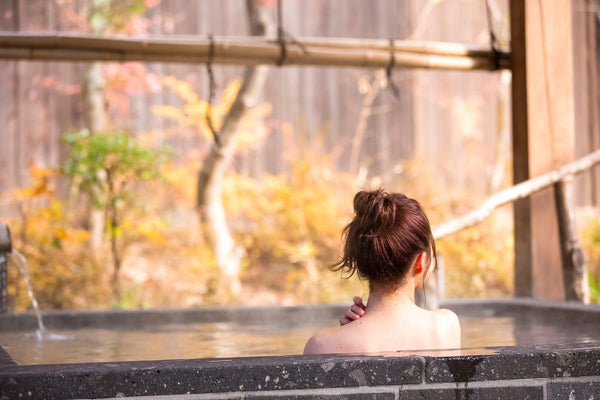
Jump to:
In a country that’s become a hotspot for global travel, visitors to Japan are seeking out new and different experiences that go far beyond what looks “good for the ‘Gram” or checks off a tourist box.
Why not consider visiting an onsen, or a traditional Japanese bath house, in a natural hot spring setting?
The time-honored Japanese hot spring baths, known as “onsen” (温泉 meaning “hot spring”), are steeped in history and surrounded by natural beauty. Onsen baths beckon travelers to an experience of relaxation and rejuvenation.
In this guide, we bring you the top 10 onsen experiences in Japan. From Hokkaido in the north, to Kyushu in the south, to the main island of Honshu along the way, we’ll break down where to get the best Japanese hot spring bath experiences on your next journey to Japan.
Why Visit a Japanese Onsen
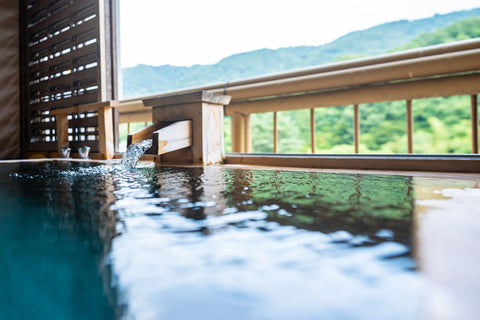
Before getting to the list of Japanese onsen, let’s take a moment with an overview of the Japanese hot spring bath and why it’s important both to Japanese people and for visitors.
We’ve covered the Japanese hot spring bath experience in this article about onsen. At its core, an onsen is more than just a bathhouse. It's a sanctuary where natural hot spring waters, infused with minerals from deep within the earth, are a means for physical and spiritual renewal.
Bath culture in Japan is, in general a big part of daily life. From baths at home to enjoying the neighborhood communal bathhouse, bathing is an important ritual that has existed for centuries in Japan.
Onsen takes it to another level, combining bathing with natural hot springs. In this inland nation that is highly mountainous and geologically potent, Japanese people embrace a natural side effect: hot spring baths.
The art of bathing in an onsen extends beyond mere relaxation; it symbolizes a connection to Japan's geological heartbeat and pays homage to the centuries-old appreciation for the healing properties of these waters.
Virtually any Japanese person, when asked whether they like visiting an onsen, will effusively answer “yes” and tell you all about the many healing and soothing properties that an onsen offers.
Top 10 Must-Visit Onsen in Japan
Embarking on a journey to discover the best onsens reveals an array of Japanese hot spring bath experiences, each deserving its place in the onsen pantheon.
If time and budget allow, consider a visit to one (or more) of these onsen hot spring bath destinations. These are the best of the best in Japan, and are each worthy of an overnight or even a weekend (with nearby sightseeing, etc).
1. Kusatsu Onsen: Top-Level Hot Springs & Well Within Reach

Nestled high in the mountains of Gunma Prefecture, Kusatsu Onsen captivates with its Yubatake, a hot water field at the town's center.
The sulfuric waters, known for their therapeutic properties, earn Kusatsu a prime spot among Japan's best Onsens. In fact, if you mention to a Japanese person that you’re planning a visit to (or have ever been to) Kusatsu Onsen, you’re likely to be greeted with a wide grin and a “good for you!” type of reply. Deservedly so, as the onsen scene in Kusatsu is second to none.
The town's traditional charm extends to the Yumomi performance, where women stir the hot spring water to cool it down in a rhythmic dance.
If you’re keen on getting the most out of your Japan trip and want to experience the best of the best in Japanese hot spring bath culture, Kusatsu Onsen is where you want to be.
How to Get to Kusatsu Onsen
Another beauty of Kusatsu Onsen is that, despite being in an idyllic location, it’s not far off the tourist path. From Tokyo, take the Hokuriku Shinkansen (bullet train) to Karuizawa, then a bus to Kusatsu. If you’re doing the Hokuriku region tour anyway, this is a must!
2. Noboribetsu Onsen: Hokkaido’s “Hell Valley”
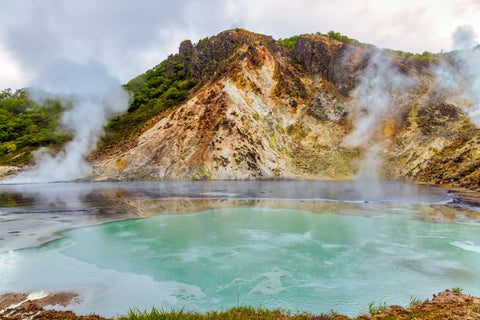
Set amidst the volcanic landscapes of Japan’s northern island of Hokkaido, Noboribetsu's Hell Valley and mineral-rich waters offer a unique Onsen adventure. The surrounding geothermal wonders add to the allure of this memorable destination.
The hot springs sourced from Hell Valley (Jigokudani) showcase the raw energy of the earth. The Hell Festival, held annually, adds a touch of mystique to this onsen experience, creating an otherworldly ambiance.
You’re sure to remember your trip to Noboribetsu, both for the onsen experience and the unparalleled landscapes. Not just good for the ‘Gram (though the photos are social media-worthy to be sure), these scenes are unforgettable to all visitors who chose to add Noboribetsu to a trip to Japan.
How to Get to Noboribetsu Onsen
Noboribetsu is ideal for either a day trip by bus or rental car from nearby Sapporo (or from your ski resort in the area). It’s also worth an overnight with meals and accommodation choices aplenty. Combined with other sights in the northern island, Noboribetsu is a featured selling point for travelers to Japan to consider adding Hokkaido to your itinerary.
3. Ginzan Onsen: Yamagata Prefecture’s Taisho Onsen Setting
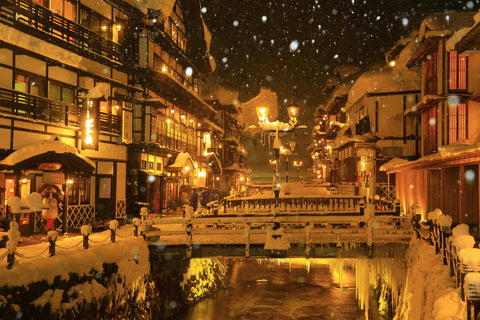
Nestled in a Yamagata valley, in northern Japan’s Tohoku region, Ginzan onsen transports visitors to the Taisho era.
The historic ryokans lining the picturesque river create a nostalgic ambiance, making Ginzan a hidden gem among Japanese Onsens. Ginzan Onsen's timeless appeal lies in its preservation of the Taisho era charm. Visitors strolling along the riverbank, with the sound of flowing water and the glow of lanterns, find themselves transported to a bygone era.
Ginzan's ability to maintain its historical ambiance amidst modern times adds an extra layer of enchantment. The historic ryokans lining the picturesque Ginzan River create a nostalgic ambiance.
How to Get to Ginzan Onsen
This is most definitely an overnight onsen destination, an ideal choice for those visiting the Tohoku region of northern Honshu. From Tokyo, it’s best to take the Shinkansen to Sendai, then make your way via car to Ginzan Onsen, approximately two hours away. Note that the Tohoku region is famous for its winter snow, which makes for natural beauty, but also the need to check weather forecasts depending on the season.
4. Kinosaki Onsen: Hot Spring Baths on the Japan Sea
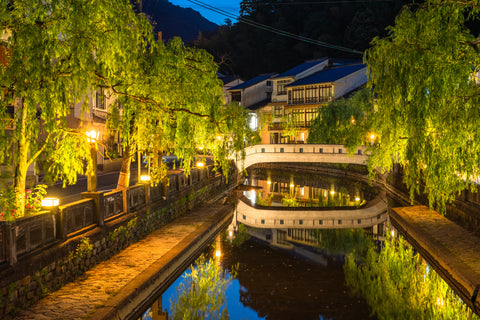
If the Kansai area is on your itinerary (Kyoto or Osaka visitors!), Kinosaki onsen is worth an add-on.
With its seven public baths and picturesque canals, Kinosaki paints a portrait of serenity. The town's ambiance, combined with diverse bath experiences, makes it a gem in the onsen crown.
Kinosaki Onsen offers year-round onsen bliss. Winter brings snow and amazing landscapes, while summer travelers can cool off in some of the best onsen baths in Japan.
How to Get to Kinosaki Onsen
It might be a bit off the beaten path, but Kinosaki is well worth an overnight or weekend. Best to book a ryokan and take a train (yay for JR pass holders!) to/from Kyoto, Osaka or Kobe.
5. Gero Onsen: Gifu’s Idyllic Hot Springs
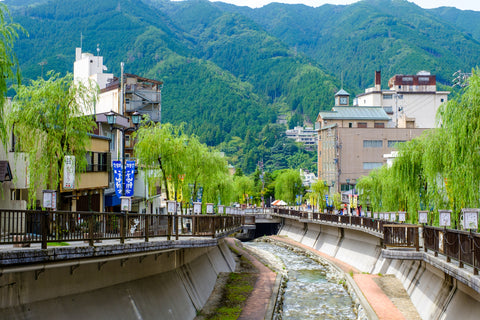
The allure of Gero lies in its three distinct public baths and the charming ryokan inns. Its riverside setting and healing waters make Gero a haven for Onsen enthusiasts.
Nestled along the clear waters of the Hida River in Gifu Prefecture, Gero Onsen enchants with its scenic setting. Three types of Onsen hot spring baths, each with its unique appeal, provide a range of experiences.
Gero's historic Gassho-zukuri style ryokans complete the immersion into Japan's architectural and cultural heritage.
How to Get to Gero Onsen
Gero is best accessed by train from Nagoya, which means it is reachable on your JR pass. It’s well within reach of both Kanto (Tokyo) and the Kansai (Osaka/Kyoto) regions.
6. Hakone Onsen: Bathing Bliss Near Tokyo
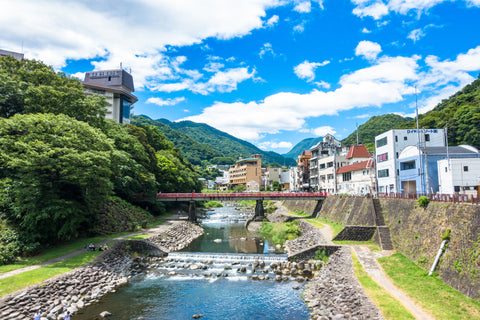
A short journey from Tokyo, Hakone's onsen hot spring baths offer a retreat to nature in an otherwise urban-centric schedule.
Surrounded by lush forests and overlooking Lake Ashi, Hakone provides a serene escape with breathtaking views.
The view of Mount Fuji on clear days can add a touch of poetic beauty to the Onsen experience – best to assume it might not be clear, then consider yourself lucky should the iconic mountain appear.
How to Get to Hakone
The Shinkansen from Tokyo will land you in nearby Odawara in less than an hour’s time, from which you can reach Hakone Yumoto station in another 15 minutes or so. It’s great for a day trip for busy Tokyo travelers, and even better when enjoyed as an overnight in one of the many ryokan inns in the Hakone area.
7. Dogo Onsen: Shikoku’s Famed Hot Spring Baths
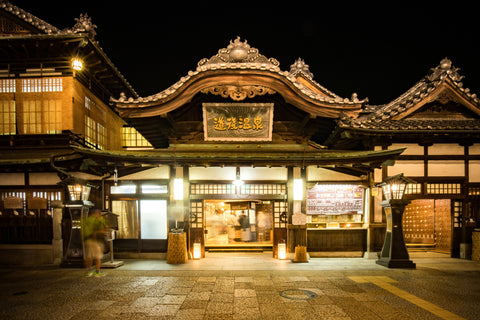
Steeped in history, Dogo Onsen's three-story wooden bathhouse exudes an old-world charm. A prime example of Japan's longstanding Onsen tradition, Dogo Onsen is ideal for those seeking a cultural immersion.
As the sun sets over Matsuyama, Dogo Onsen takes on a magical quality. Illuminated against the night sky, the Dogo Onsen Honkan becomes a beacon of timeless appeal. The architectural grace and historical significance make Dogo Onsen a classic Onsen experience.
How to Get to Dogo Onsen
Dogo Onsen is located on the island of Shikoku. While it’s off the beaten path in general, this region will reward visitors with experiences you’re likely not to get in Tokyo or Kyoto. The nearest city is about 30 minutes away: Matsuyama. Here you’ll have train and air connections to/from Tokyo, Osaka and elsewhere on your Japan travel itinerary.
8. Beppu Hatto Onsen: Venture to the Island of Kyushu
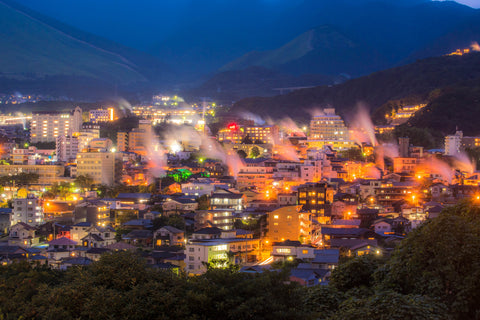
Okay, onsen lovers, it’s time to head south!
Beppu, an Onsen city on the southern island of Kyushu in Oita Prefecture (itself practically synonymous with volcanoes and Japanese Onsen hot spring baths), stands out for its diverse range of experiences, from mud baths to sand baths. Hatto Onsen are a ring of eight hot spring baths in the Beppu area.
The town's versatility makes it a captivating destination for Onsen aficionados. Oita Prefecture boasts some of the best food in Japan as well, so you really can’t go wrong here.
How to Get to Beppu
You can easily reach Beppu as a day trip from Fukuoka (JR Pass holders rejoice) or make it an overnight stay and see nearby Onsen towns like Yufuin or the Onsens of Mount Aso region.
9. Kurokawa Onsen: Further Afield in Kyushu
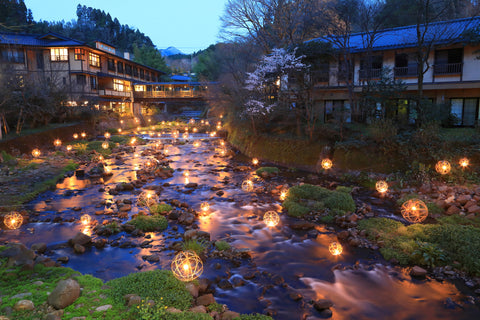
Escape to Kurokawa Onsen, a gem nestled in Kyushu's mountains. Soak in over 20 unique hot springs, each ryokan offering a blissful escape.
Stroll the charming, forest-lined streets in traditional yukata, past ryokan inns, bathhouses and quaint shops. This compact town exudes tranquility, inviting you to unwind.
No towering hotels or neon here, just natural beauty and wooden buildings framing a gentle river. Kurokawa Onsen cherishes its traditional soul, offering a classic Japanese hot spring bath experience.
How to Get to Kurokawa Onsen
The shinkansen bullet trains will get you as far as Kumamoto, from which you can get to Kumamoto Onsen by rental car or bus. Consider a regional pass that covers other onsen as well.
10. Ibusuki Onsen: Hot Springs Of The South
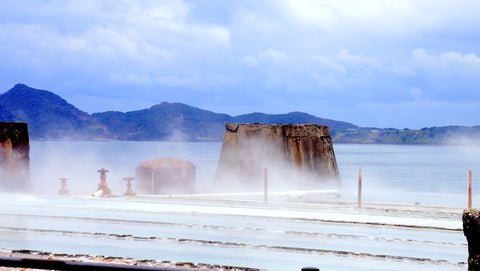
On the southern tip of Kyushu, in Kagoshima prefecture, Ibusuki Onsen takes Onsen therapy to a unique level.
Here, visitors are buried in naturally heated volcanic sand—a practice known as “sunamushi.” The combination of the therapeutic sand and the seaside location creates a sensory experience that goes beyond traditional Onsen bathing.
The seaside setting adds an extra layer of tranquility to this unconventional yet therapeutic Onsen.
How to Get to Ibusuki Onsen
Reaching this area involves a train connection from the end of the Kyushu Shinkansen bullet train line, so we recommend spending a night here. Another option is to take a domestic flight (from Tokyo or Osaka) into Kagoshima and begin your Kyushu journeys in this area.
Honorable Mention: Arima Onsen
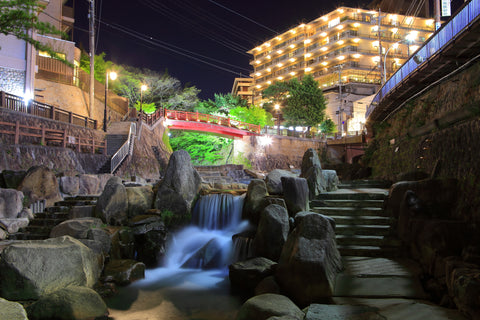
Tucked in the lovely Rokko Mountains, Arima is distinguished by its golden and silver mineral-rich waters. The medicinal properties of these Onsen, coupled with the town's serene setting, create a great retreat from your visits to nearby Kyoto, Osaka and/or Kobe.
Don’t have time for Kinosaki Onsen? Arima Onsen is a great alternative. Or maybe you went to Kinosaki, loved it, and want another onsen in the Kansai region? Arima is right here for you to enjoy!
How to Get to Arima Onsen
Arima Onsen is easily accessed by bus from Osaka or Kobe’s Sannomiya station, and should be well considered for a day trip or even an overnight.
Other Onsen On Your Japan Travel Itinerary
Pressed for time and not keen or able to venture out for now? Google “onsen” or “hot spring” near your location, and you’re sure to find a local spot that’s nearby and makes a great foray into Japan’s Onsen hot spring bath culture. Some city onsen even have pipelines that bring in the mineral-rich water from nearby sources. If you’re staying in a hotel, inn or guesthouse, ask the staff what’s good nearby.
Don’t be shy about trying a new experience; your future self will thank you!
Day Trip vs Overnight: Which Onsen Experience Is Right for You?
When it comes to visiting an onsen, start with a basic choice: Do you want to make it a day trip, or would you be willing to spend the night and be rewarded with greater immersion (literally and figuratively)?
A day trip to an onsen that’s near your other travel destinations (such as Arima Onsen, with its proximity to Osaka and Kyoto, or an Onsen that’s easily on the road as you travel through vast areas like Kyushu or Hokkaido) makes for a great stop. Here you can soak in the baths, enjoy a snack or meal, and then move on to other destinations.
Planning an overnight at an Onsen destination, meanwhile, gives you more layers of complexity and enjoyment, in both physical relaxation as well as cultural appreciation.
Staying at a Ryokan: Japan’s Traditional Inns
Consider staying at a ryokan, the popular Japanese inns that are operated by local proprietors and offer a meal-room-onsen package you’ll surely remember.
A ryokan offers comfortable accommodation, finely prepared Japanese meals (typically dinner and breakfast), as well as use of the inn’s hot spring baths. Some ryokan offer accommodation with hot spring baths inside the room or on a private balcony – an experience you’re likely not to forget anytime soon.
Ryokan come with a bit of a price tag, but consider that you’ll be enjoying good meals and immersing yourself in a memorable experience.
Best Time to Visit Onsen in Japan
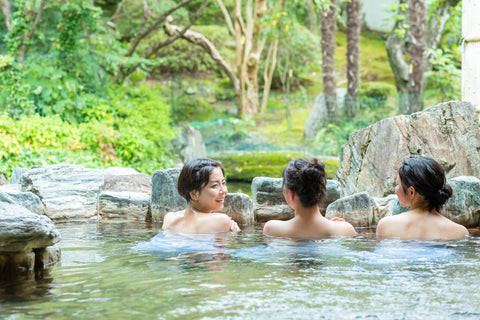
When’s the best time to visit an Onsen? Really, it’s hard to go wrong here!
We suggest you plan your overall travel schedule first, as Japan most certainly has high and low seasons, with some weather challenges to be aware of. Then take into account where you’ll be and where the nearest Onsen are.
Spring and Autumn: Onsen in Great Weather
Mild temperatures during spring and autumn make these seasons ideal for Onsen visits. Imagine immersing yourself in outdoor baths surrounded by blooming cherry blossoms or vibrant fall foliage.
Onsen in Winter: Wonderful Way to Warm Up
Winter transforms Onsens into steamy sanctuaries against snow-covered landscapes. The juxtaposition of warm waters and cold air creates a magical ambiance, making winter a popular Onsen season.
Summer Onsen Experience: Refreshing Times
Summers in Japan tend to be very hot and humid. Does it seem counterintuitive to visit an Onsen at such a time? Perhaps. But, it turns out, an Onsen experience in the summertime is a great way to beat the heat and find refreshment and rejuvenation along your journey to Japan.
Onsen Etiquette You Should Know
Before you step into the tranquil environs of an onsen, understanding and respecting Onsen etiquette will help ensure a smooth and harmonious experience.
The onsen hot spring ritual begins with thorough cleansing and rinsing before entering the communal bath.
Once in the onsen, keep towels out of the water; also, please refrain from swimming or splashing. The quiet ambiance of an Onsen demands a respectful demeanor to preserve the serene atmosphere for all visitors.
Tattoos, once a barrier to onsen entry due to their association with the yakuza (Japan’s version of organized crime), are becoming less restrictive at many establishments. If you or a travel companion have a tattoo, researching tattoo-friendly onsens or those with designated tattoo-friendly times is essential.
Why No Trip to Japan Is Complete Without an Onsen Experience
The typical visitor to Japan hits up Tokyo and Kyoto, with some possible additions such as Osaka, Hiroshima and/or other regions.
A great part about adding an onsen to your journey is that, thanks to Japan’s fantastic transportation infrastructure, you won’t likely have to detour too drastically to enjoy a fine Onsen experience.
Not only will you be able to appreciate more of Japan’s culture and history by visiting a Japanese hot spring bath, an onsen experience will leave you feeling relaxed, rejuvenated and ready to continue with your exciting travel adventures!
The therapeutic properties of onsen waters are a gift to both body and soul.
Rich in minerals, the natural hot springs of Japan’s onsen are believed to alleviate aches, improve circulation and cleanse the skin. The act of soaking in an onsen transcends the physical; it offers a meditative experience, a moment to reflect, unwind and find harmony amidst the soothing waters in a tranquil setting. Onsen visitors emerge not only physically revitalized but also spiritually uplifted, carrying a vibe and energy that will boost the remainder of your travel experience in Japan.
Soak, Relax, and Reconnect
The Japanese onsen hot spring bath, with its distinctive character and therapeutic embrace, is an invitation to slow down, immerse in the moment and connect with the essence of a culture steeped in tradition.
From the ancient charm of Dogo Onsen to the scenic allure of Kusatsu, from Hakone to the Hells of Noboribetsu, Japanese Onsen offer history, nature and cultural immersion. Let the mineral-rich waters and serene landscapes of Japan’s Onsen scene transport you to a place of tranquility and cultural significance.
Want to bring the onsen experience home? Explore our curated collection of Japanese bathing essentials like hinoki bath stool, hinoki bath bucket, hinoki bath mat, exfoliating towels, and hinoki incense to recreate the calm, rejuvenating feel of a real onsen, wherever you are.


1 comment
nice onsen
miyajaki,